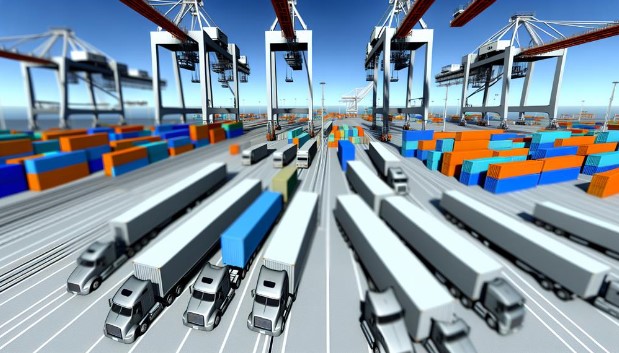While it’s easy to assume that the complexity of intermodal trucking makes streamlining an insurmountable task, you’ll find that integrating cutting-edge technologies and forming strategic industry partnerships can significantly simplify processes. By optimizing route planning and enhancing real-time GPS tracking, you’re not just improving efficiency but also cutting down on costs and boosting service quality. Consider how advanced data analytics could transform your operational insights, leading to smarter decision-making. What’s more, think about the untapped potential that these partnerships might unlock in navigating the regulatory and logistical hurdles you face every day. What could this mean for the future of your operations?
Optimizing Route Planning Strategies
To effectively tackle the complexities of intermodal trucking, you must optimize your route planning strategies to enhance efficiency and reduce operational costs. Utilizing advanced traffic prediction models is crucial. These models analyze historical and real-time traffic data, allowing you to anticipate delays and avoid congestion. By integrating these predictions into your planning, you’re not just reacting to conditions as they occur; you’re staying ahead of them.
Equally important is weather impact analysis. This involves studying how different weather conditions affect route accessibility and driving conditions. For instance, heavy rain or snow can cause significant delays and even route closures. By analyzing weather patterns and forecasts, you can adjust your routes or schedules ahead of time, mitigating risks associated with adverse conditions.
Incorporating both traffic and weather data into your route planning isn’t just about avoiding delays—it’s about optimizing the entire journey. Strategic planning based on comprehensive data analysis ensures that you’re choosing the most efficient routes, ultimately saving time and fuel. This proactive approach not only boosts your operational efficiency but also enhances your ability to meet delivery deadlines and maintain customer satisfaction.
Enhancing Real-Time GPS Tracking
Building on optimized route planning, enhancing real-time GPS tracking further improves your ability to navigate unpredictable conditions on the road. By focusing on signal integrity, you ensure that the data transmitted between your vehicle and the tracking system is accurate and uninterrupted. This is crucial when you’re dealing with areas of weak GPS signals or when environmental factors might disrupt transmission. Signal integrity isn’t just about maintaining a constant connection; it’s about ensuring the information you receive is precise and timely, enabling you to make quick decisions in real-time.
Moreover, optimizing battery efficiency in your GPS devices is equally strategic. Enhanced battery efficiency means your tracking systems are reliable over longer periods, even when external power sources aren’t available. This is particularly important in intermodal trucking, where vehicles might traverse remote areas. Implementing GPS trackers with better battery life reduces the risk of losing signal due to power failure, thus maintaining continuous monitoring and improving overall fleet management.
These enhancements in GPS tracking technology not only boost your operational efficiency but also equip you to handle the complexities of modern logistics with greater confidence. By investing in advanced GPS solutions, you’re setting up a more resilient and responsive navigation system.
Strengthening Regulatory Compliance
Strengthening regulatory compliance in intermodal trucking is essential for ensuring your operations adhere to industry standards and avoid costly penalties. It’s critical to stay updated with the ever-evolving landscape of regulations that impact your sector. This means regularly revising your compliance strategies and ensuring that all your staff, especially drivers, are up to speed.
Investing in comprehensive driver training programs can make a significant difference. These shouldn’t only cover the basics of safe driving but also detailed regulatory requirements specific to intermodal trucking. For instance, understanding the complexities of cross-border regulations, hazardous material handling, and Hours of Service (HOS) rules are imperative. You’ll find that well-trained drivers are less likely to violate regulations, reducing the risk of fines and boosting your company’s reputation.
Furthermore, keeping your policies in sync with the latest regulations is crucial. Regular policy updates should be a fixture in your operational strategy, ensuring that any changes in laws are quickly reflected in your day-to-day operations. This proactive approach not only helps in maintaining compliance but also in preparing your team for any regulatory inspections or audits that might arise. Remember, compliance isn’t just about avoiding penalties; it’s about ensuring safety, efficiency, and reliability in your service delivery.
Advancing Equipment Management
While maintaining regulatory compliance is foundational, equally important is enhancing your approach to equipment management to ensure operational excellence. You’ve got to adopt advanced automated scheduling systems. These tools don’t just allocate vehicles and drivers efficiently; they predict needs based on historical data and upcoming demands. It’s about not just reacting to what’s next, but strategically preparing for it.
Implementing rigorous maintenance protocols is crucial. Think of it as preventive healthcare for your fleet. Regularly scheduled check-ups prevent breakdowns that can cost you time and money, not to mention damage your reputation. Each vehicle should have a tailored maintenance plan that addresses its specific usage patterns and operational demands. This isn’t a one-size-fits-all situation; each plan must be as unique as the equipment it serves.
You’ll need to analyze the data collected from these protocols. It’s not enough to collect information; you’ve got to use it to make informed decisions. This might mean adjusting your maintenance schedules based on the performance metrics or even revising your automated scheduling configurations to better match equipment availability with demand. This strategic, data-driven approach ensures that your equipment management isn’t just keeping pace—it’s setting the pace.
Fostering Strategic Industry Partnerships
Forming strategic partnerships within the industry can significantly enhance your operational capabilities and competitive edge. By engaging in partnership models that leverage collaborative technology, you’re not just sharing resources but also integrating innovative solutions across your supply chain. This approach allows for a more cohesive strategy in tackling the complex logistics and regulatory landscapes you face daily.
Consider the power of data-sharing platforms within these partnerships. By utilizing collaborative technology, you can access real-time information from partners, enhancing your decision-making processes and allowing for proactive rather than reactive management. This shared data environment leads to increased transparency and efficiency, essential for optimizing route planning and reducing downtime.
Moreover, collaborative partnerships can help you navigate the regulatory requirements more smoothly. With partners that bring different expertise and insights, you’re better equipped to comply with emerging regulations and standards, which can vary significantly across regions.
Strategically, these partnerships enable you to tap into a broader network of resources, including advanced technological tools and expert knowledge, which can be cost-prohibitive to develop independently. They also open doors to new markets and customer bases, facilitated by the enhanced capabilities and expanded reach that such alliances provide.
Streamlining Cargo Handling Processes
Building on strategic industry partnerships, you can further enhance operational efficiency by streamlining cargo handling processes. By integrating automated loading systems, you’re not just speeding up the transfer of goods, but also significantly reducing human error and labor costs. Automated loading technology ensures that cargo is handled consistently and placed precisely, thereby minimizing damage and improving safety during operations.
Moreover, effective warehouse scheduling is crucial in optimizing the flow of goods. By implementing advanced scheduling software, you can predict and manage the influx of cargo, ensuring that resources are allocated efficiently. This software allows for real-time tracking of inventory levels, vehicle locations, and loading dock availability, which in turn facilitates quicker decision-making and reduces bottlenecks in the supply chain.
To maximize these technologies, it’s essential you integrate data analytics to monitor performance and identify trends. Regular analysis helps refine both automated loading operations and warehouse scheduling, ensuring continuous improvement in handling times and resource utilization. Remember, the goal is to streamline processes to such a degree that downtime is minimized, and throughput maximizes profitability. Strategically applying these tools in tandem with your industry partnerships will position you at the forefront of logistical efficiency in intermodal trucking.




